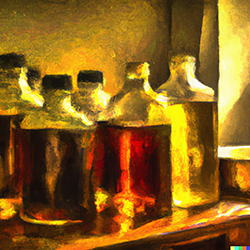The Advantages of Malt Extracts!
Posted by Matteo Lahm on 17th Jan 2023
Liquid malts are created by a process called mashing. This process involves soaking grains (usually barley) in hot water for an extended period of time to convert their starches into sugars. The resulting liquid is then separated from the grains and boiled, which allows the sugars to caramelize and give the liquid a deeper color and flavor.

The advantages of using liquid malts are that they are more convenient and easier for you to use than actual grains. They also require much less equipment and space, as they are pre-mashed and can be easily stored. Additionally, they provide a consistent flavor profile to your beer.
Examples of different Malt Extracts:
1. Light Malt Extract: Light malt extract is made from pale malted barley and produces a light, crisp flavor.
2. Amber Malt Extract: Amber malt extract has a richer, more complex flavor due to the addition of darker malts, such as chocolate and crystal malts.
3. Dark Malt Extract: Dark malt extract is made with a combination of dark malts, such as black malt, chocolate malt, and roasted barley. It produces a deep, roasted flavor.
4. Wheat Malt Extract: Wheat malt extract is made from malted wheat, and it produces a sweet, bready flavor.
5. Specialty Malt Extracts: Specialty malt extracts are made from a variety of specialty malts, such as smoked malt, caramel malt, and fruit-flavored malts. They produce unique flavors that can range from smoky and sweet to tart and fruity.
The disadvantages of using liquid malts are that they are more expensive than actual grains and can only provide you with a limited range of flavors. They also don’t provide the same level of complexity that grains can, and they may not be as fresh or as flavorful.

Liquid malts were first developed in the late 19th century as a way to simplify the process of making beer. Since then, they have become a popular and convenient way to add flavor and color to beer without the hassle of mashing grains. The process of making liquid malts was perfected by a German brewmaster named Anton Dreher in the early 20th century. He developed the process in Vienna, Austria, and it quickly spread to other countries.
Liquid malts are used in a variety of beers, including stouts, porters, and ales. They are typically added at the beginning of the brewing process, when the wort is being boiled. The liquid malts provide the desired colors and flavors that are associated with the beer style. They can also be used to adjust the body and mouthfeel of your beer.
It is common to combine different types of malts to create a unique flavor profile. This is often done by adding different types of malts at different points in the brewing process. This allows you to create a wide range of flavors and complexity in your beers.
So if you are new to beer brewing and/or have a small operation, malt extracts are a great way to simplify your process and get a more predictable result. They are also a good way to learn about how different types of malt flavors produced different flavors, mouthfeels and colors. Once you have mastered making beer with malt extracts and you have done a bit of research, you will be ready to try working with grains and have the know-how to get it right. Good luck!

